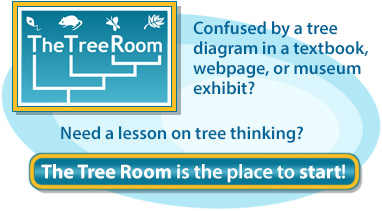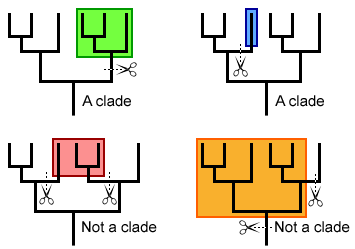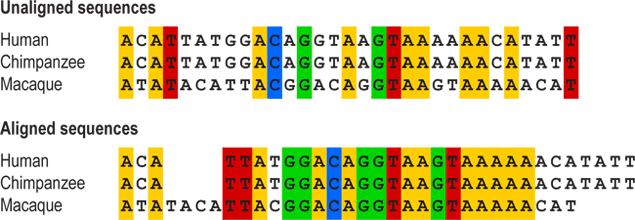Way back last summer, I wrote a four-part Misconception Monday series on evolutionary trees (part 1, 2, 3, 4). What I couldn’t tell you back then was that the inspiration for the series was a new section of the incomparably fabulous Understanding Evolution (UE) site. At the time, the UCMP folks asked me to hold off on advertising the section until they got their evaluations back from external assessors. Grudgingly, I held off. Then, when the site went live in September, I was swamped and didn’t do what I should have done—loudly sing i ts praises on the blog. It’s true that some of my extra workload involved writing Evo in the News articles for the UE site, but I still feel pretty horrible that I haven’t championed its new triumph yet. My guilt ends today. Everyone, get ready for awesome and go explore The Tree Room!
ts praises on the blog. It’s true that some of my extra workload involved writing Evo in the News articles for the UE site, but I still feel pretty horrible that I haven’t championed its new triumph yet. My guilt ends today. Everyone, get ready for awesome and go explore The Tree Room!
From the front page:
Over 150 years ago, Darwin chose the tree of life as a metaphor for one of the most powerful ideas in biology: the relatedness of all living things. The power of that idea can be seen today in the ubiquity of evolutionary trees (also called phylogenetic trees) in all biological disciplines, from studies of newly discovered species to cutting-edge cancer research. Correspondingly, evolutionary trees have made their way into textbooks, museum exhibits, and the media. To understand modern biology, we all need to understand how evolutionary trees can be read and used. The Tree Room provides a wide variety of tools for teaching and learning about evolutionary trees in both classrooms and informal science education settings.
There is a lot to love here. As with all of Understanding Evolution (and Understanding Science, for that matter), a clear and engaging writing style is used to thoroughly explore rich and challenging content. The science is presented narratively with a relaxed ease. Trees, being visual models of relatedness, cannot be taught without graphics, and the site uses them to great effect.
 The primer, which could also be called Trees 101, unfolds page by page in a very deliberate and thoughtful manner. If you have a question at the end of one page, there is a good chance it’ll be answered on the very next one. Once again, the UCMP team members show themselves to be masters of pedagogy.
The primer, which could also be called Trees 101, unfolds page by page in a very deliberate and thoughtful manner. If you have a question at the end of one page, there is a good chance it’ll be answered on the very next one. Once again, the UCMP team members show themselves to be masters of pedagogy.
A highlight for me is, of course, the tree misconceptions page. Common misconceptions are grouped by the intuitive idea that underlies them. When researching my posts, I found their explanations of where the misconceptions come from to be very helpful. Sometimes, when you know a lot about something, it can be difficult to wrap your head around why someone else doesn’t get it. Notes about intuitive concepts helps you get that “oooh, I get where this is coming from” moment that can then be turned into, “…and I see how I can help to correct it!” A great tool for any educator.
My absolute favorite part of the site is not the misconceptions, however—it’s what they call the field guide to evolutionary trees. This interactive tool lets you explore different tree styles and see how one style translates into another. I must admit that I didn’t know how to properly read circular phylogenetic trees! It wasn’t until I was exploring the field guide that I came to understand how to read the branching pattern and translate it into a more familiar form. You can learn so much about trees from the field guide, and a teacher could easily craft activities that would help ensure their students become master tree-readers.
 For example, you could have students find a tree in a scientific paper or other source and use the field guide to decipher it and to answer questions such as, Why do you think the researchers chose this kind of tree? What do you think works well on this tree? What do you think is unclear? This type of exercise is common in math classes learning about various graph types; why not do the same with trees? (Just when I was patting myself on the back for coming up with this great activity idea, I realized that it is one of many suggested on the two- and ten-minute trees page. Those darn UCMP-ers, always one step ahead of me!)
For example, you could have students find a tree in a scientific paper or other source and use the field guide to decipher it and to answer questions such as, Why do you think the researchers chose this kind of tree? What do you think works well on this tree? What do you think is unclear? This type of exercise is common in math classes learning about various graph types; why not do the same with trees? (Just when I was patting myself on the back for coming up with this great activity idea, I realized that it is one of many suggested on the two- and ten-minute trees page. Those darn UCMP-ers, always one step ahead of me!)
Other sections of the site include the rigorous how to build a tree, which covers the types of evidence and analyses used to develop tree models. Do you want to know how to explain parsimony to your students or need a refresher yourself? Do you have a student that wonders how DNA is used to build trees or why certain other traits aren’t? Go here. Yes, there is a lot of text and detail, but I guarantee you’ll understand trees a lot better.

The trees matter corner of the page provides a few different answers to the oft-asked “why does this matter?” question. Check it out so you can reply with confidence: “Because it’s helpful to know where emerging diseases came from; if you ever get bitten by a poisonous snake, you’ll want the antivenom; and because people like giant tortoises.” (Why, yes, there are stories behind all the parts of that reply, as it happens, and UE tells them with insight and verve.)
Finally, there is a great section for museums and zoos to help them generate the best teaching-trees and learning opportunities for visitors. In other words, if you work in a museum or zoo, please read the section so that I can write a Well Said! and not a Say What? post about your display. But it’s not just for zoos and museums! The tree design tips shows before and after tree sets and explains the research in support of drawing trees in certain ways and not in others. You’ll never draw another diagonal or broom-like tree again!
So in sum: The Tree Room deserves praise, and the UCMP team yet again earns my gratitude for providing an invaluable tool to anyone hoping to understand, use, or teach the ins and outs of the most important type of diagrams in evolution.
Are you a teacher and want to tell us about an amazing free resource? Do you have an idea for a Misconception Monday or other type of post? Have a fossil to share? See some good or bad examples of science communication lately? Drop me an email or shoot me a tweet @keeps3.

